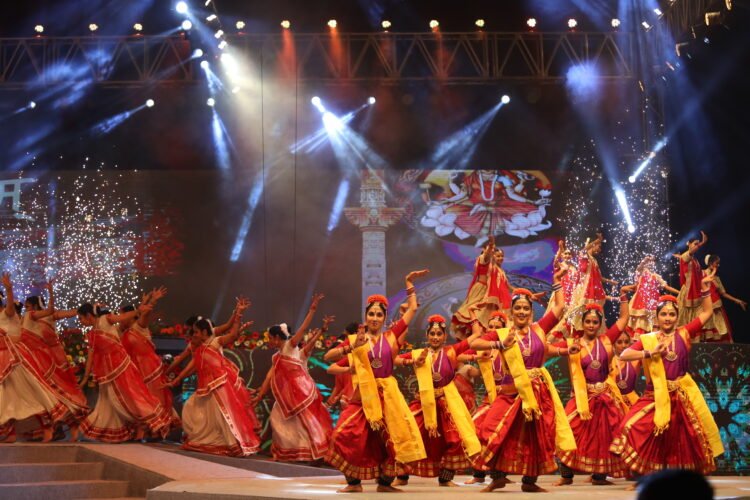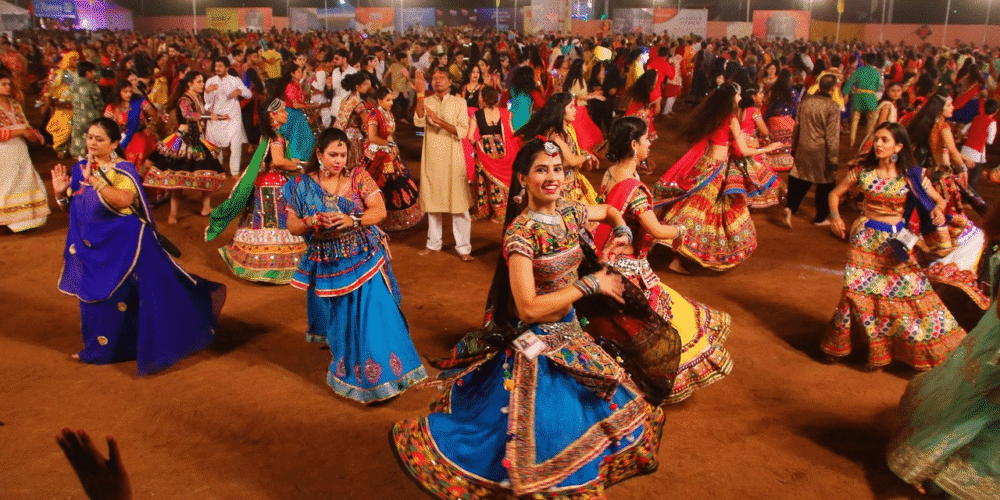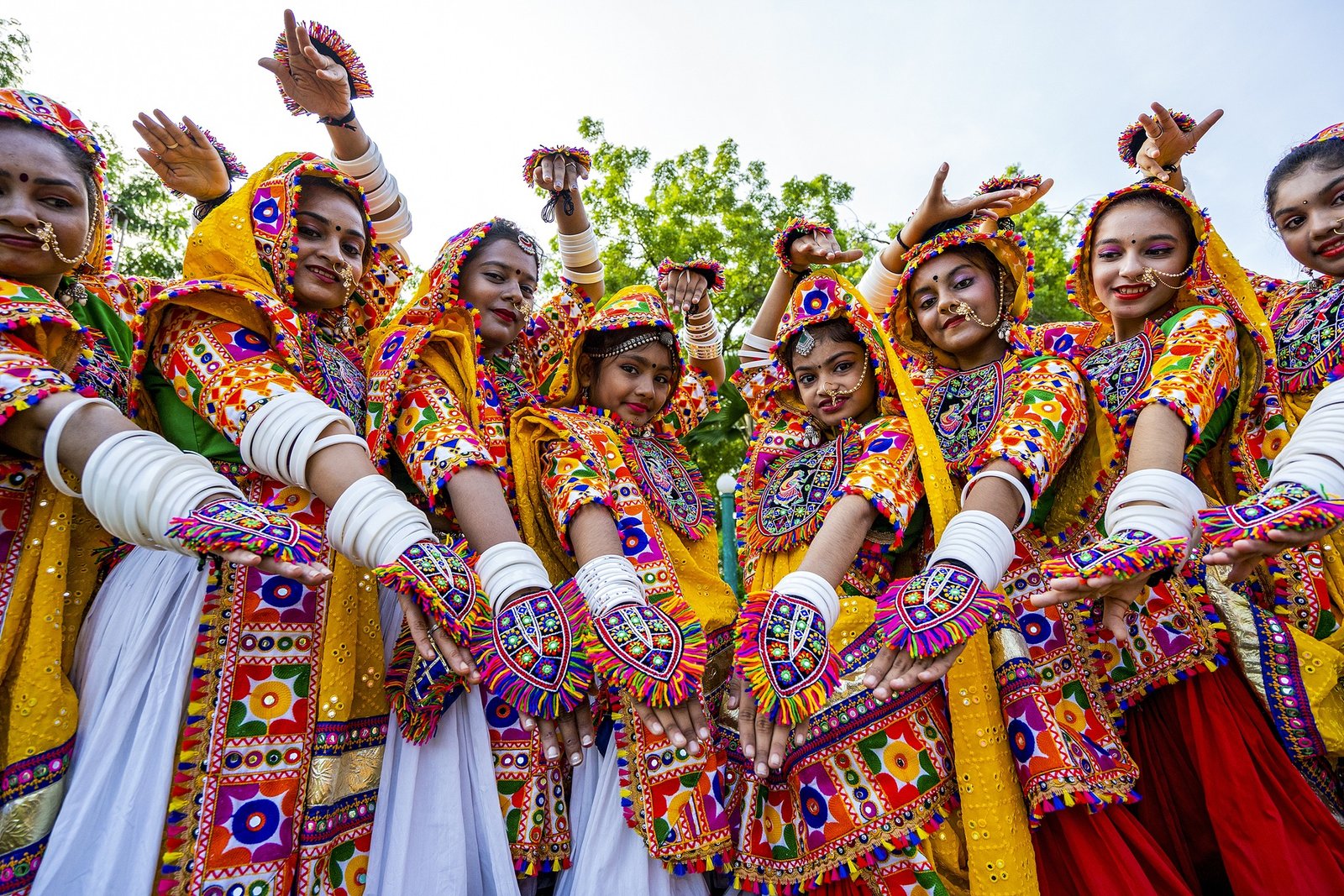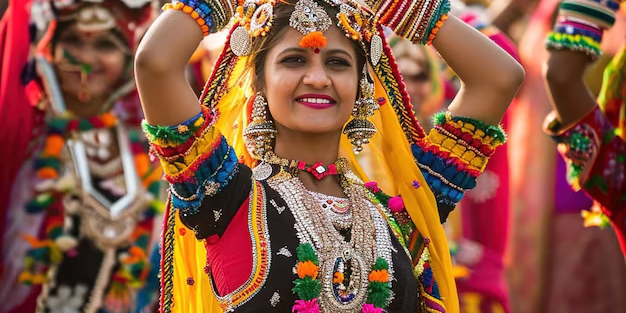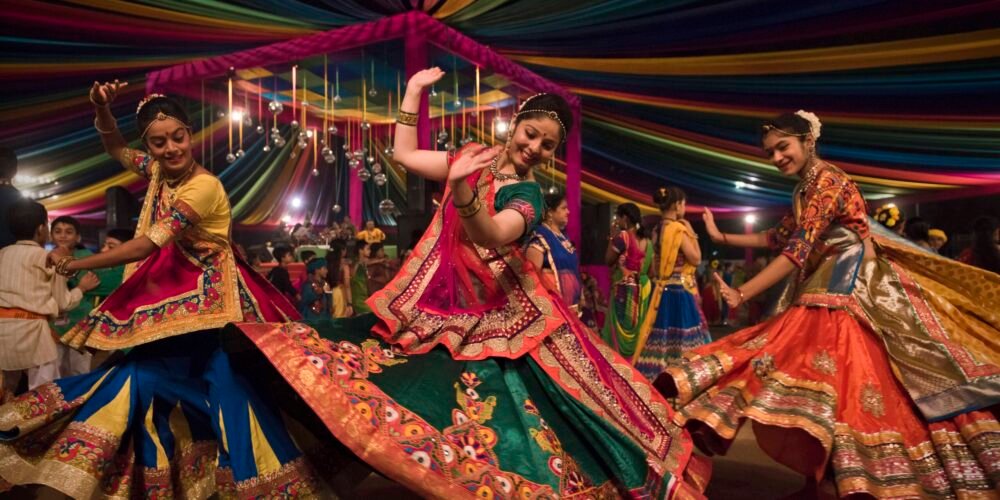No products in the cart.
Navratri – Gujarat’s Festival of Dance and Devotion
Navratri in Gujarat is not just a festival but a cultural spectacle where devotion meets celebration. Rooted in the worship of Goddess Shakti and inspired by Krishna’s playful Ras Leela, the vibrant garba circles symbolize unity, joy, and spiritual energy. For nine nights, the state comes alive with music, color, and dance, making it one of the most enchanting festivals in India.
By Sangeeta Srivastava
A Glimpse into the Celebration
Navratri, literally meaning nine nights, is among the grandest Hindu festivals across India. Nowhere, however, does it come alive with as much energy and spectacle as in Gujarat, where the entire state transforms into a stage for dance and devotion. For nine consecutive nights, towns and villages resound with the rhythm of garba and dandiya, celebrating the feminine power of Shakti.
The graceful ras garba, rooted in the Krishna–Gopi traditions of Saurashtra and Kutch, blends devotion with joy. Music inspired by tales of Krishna’s playful bond with the Gopis sets the mood, while communities gather around a central shrine dedicated to the Goddess. At the heart of each shrine is the garbo—an earthen pot filled with symbolic offerings of coconut, betel nut, and silver coin.
Each set of three nights is devoted to a different goddess: Durga the destroyer of evil, Lakshmi the harbinger of prosperity, and Saraswati the giver of wisdom. The festival also honors fertility and the harvest season, represented by freshly sown grains in a mound of soil.
As the evening prayers conclude, the beats take over. Circles of dancers whirl endlessly, sometimes adding swords, lamps, or intricate steps to the performance. Traditional rhythms once created only with drums and voices now often blend with modern sound systems, giving the festival both a timeless and contemporary feel. Vadodara, especially, is famed for showcasing every shade of this dance tradition—from the simple and soulful to the elaborate and experimental.
The tenth day, Dussehra or Vijayadashami, marks the festival’s grand finale. Vehicles are blessed, new purchases are made, and families indulge in the beloved Gujarati combo of fafda and jalebi.
Beyond devotion, the garba circle has a magnetic, spiritual quality. Many women observe dietary vows, and even the most reserved participants let loose in joyful whirls, surrendering to the rhythm that symbolizes the universal creative energy.
Time to Celebrate
Navratri is celebrated for nine nights starting from the first day of the bright fortnight of Ashwin in the Hindu calendar. In 2025, the festival will be held from 22nd September to 2nd October, followed by Dussehra on the tenth day. The timing beautifully coincides with the close of the monsoon season.
Where to Witness It
Step into almost any part of Gujarat during Navratri, and you’ll find garba grounds buzzing with music and color. Ahmedabad and Vadodara are the cultural hotspots, offering everything from traditional garba to grand themed events. Yet, village garbas carry a rustic charm worth experiencing too.
Pilgrims often combine the festivities with visits to major Shakti shrines like Ambaji, Pavagadh, and Bahuchraji, or famous temples such as Ashapura Mata-no-Madh in Kutch, Khodiyar Mandir near Bhavnagar, and Chamunda Mata Mandir at Chotila.
For a large-scale urban celebration, head to the Gujarat University Grounds, Ahmedabad, where themed pavilions, craft bazaars, food courts, and cultural zones bring Navratri to life. Also many others Groups Organise Navratri Festivals .
Stories Behind the Festival
The roots of Navratri are woven with powerful myths:
- The Legend of Mahishasura: The demon, immune to men’s weapons, wreaked havoc until the gods created the fierce Goddess Shakti. Riding a lion and armed with divine gifts, she fought him for nine nights and finally defeated him on the tenth day, giving rise to Navratri and Dussehra.
- The Tale of Sati: Sati, humiliated by her father’s insult toward Lord Shiva, immolated herself in a sacrificial fire. Reborn as Uma, she later reunited with Shiva. During Navratri, it is believed Uma visits her parents’ home each year with her children and companions, symbolizing love, reunion, and maternal bonds.
These timeless legends continue to infuse Navratri with meaning, ensuring its celebration remains both spiritual and festive.
Who Joins the Festivities
While Navratri is deeply rooted in Hindu tradition, its joyous garba nights often see participation across communities. The festival’s rhythm and energy invite everyone to dance, celebrate, and connect with the divine feminine spirit.
About Garba
Garba is most commonly associated with the worship of Goddess Shakti, but its roots are also closely tied to Lord Krishna and his playful traditions.
- Ras Leela Connection
- The circular dance style of ras garba is inspired by Ras Leela, where Lord Krishna danced with the Gopis of Vrindavan under the moonlit sky.
- The same circle pattern is seen in garba: dancers moving around a central symbol (the lamp, pot, or goddess shrine), much like Krishna being the center of the Gopis’ devotion.
- Saurashtra & Kutch Influence
- In Gujarat’s Saurashtra and Kutch regions, garba absorbed elements of Krishna worship. The songs, music, and stories often narrate Krishna’s love, his flute, and the emotions of the Gopis.
- Symbolism of Love & Devotion
- Just as the Gopis lost themselves in Krishna’s presence, garba dancers lose themselves in rhythm and devotion.
- The dance becomes both a celebration of feminine divinity (Shakti) and a remembrance of Krishna’s eternal bond with his devotees.
So, while Navratri garba primarily honors the Goddess, its style and spirit are deeply influenced by Krishna’s ras tradition, blending bhakti (devotion) with joy.


